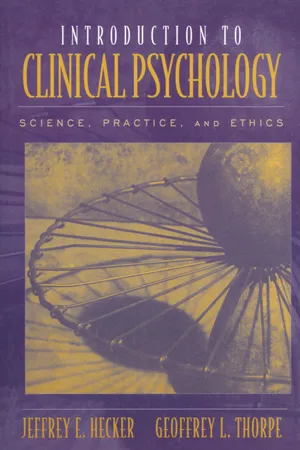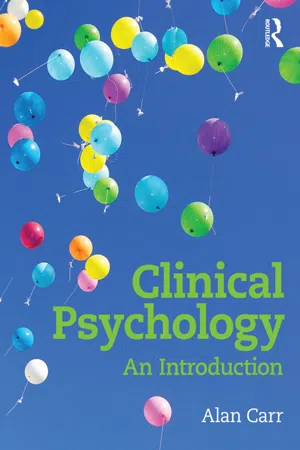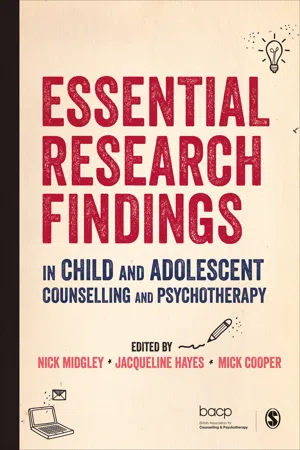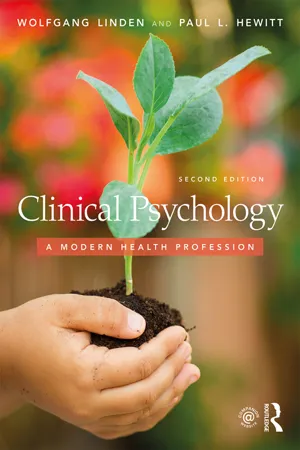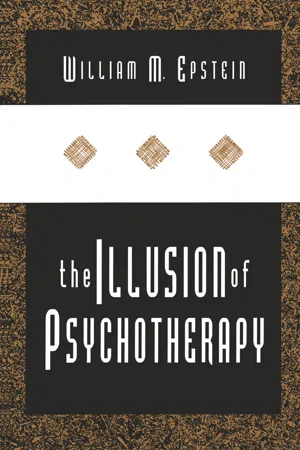Psychology
Effectiveness of Therapy
The effectiveness of therapy refers to the degree to which a therapeutic intervention produces the desired outcomes for a client. It is typically measured by assessing changes in symptoms, functioning, and overall well-being. Evaluating the effectiveness of therapy involves considering factors such as the type of therapy used, the client's specific needs, and the quality of the therapeutic relationship.
Written by Perlego with AI-assistance
Related key terms
Related key terms
1 of 4
Related key terms
1 of 3
7 Key excerpts on "Effectiveness of Therapy"
- eBook - ePub
- Jeffrey Hecker, Geoffrey Thorpe(Authors)
- 2015(Publication Date)
- Psychology Press(Publisher)
effectiveness studies are another viable paradigm. An effectiveness study examines the effects of a psychotherapy as it is actually delivered in the field. In contrast to efficacy research, in an effectiveness study, treatment manuals are not used, duration of treatment is determined by the client’s progress or other real-world factors (e.g., insurance limits, client or therapist moves), clients may have multiple problems, and they choose their therapists and therapy modality based upon availability, therapists’ reputations, and the clients’ belief that they will be helped by the therapist/therapy. In effectiveness research, psychotherapy clients might be surveyed about the response to the treatment they received. Alternatively, naturally occurring information may be gathered about clients who received treatment. For example, divorce rates for clients seen for marital therapy, rearrest records for treated sexual offenders, or rehospitalization rates of severely mentally ill patients may be gathered to examine the impact of psychological interventions delivered in the field.Efficacy and effectiveness research can be seen as two complementary approaches to addressing questions about whether psychotherapy is helpful. The main purpose of an efficacy study is to establish that the treatment has an effect. For the effectiveness study, the goal is to demonstrate the generalizability, feasibility, and cost effectiveness of the treatment (Jacobson & Christensen, 1996). Effectiveness research is carried out after a treatment has been shown to be helpful under controlled conditions. Unfortunately, there are very few examples of effectiveness research in the psychotherapy field at this point in time. A notable, and controversial, example is the Consumer Reports study discussed in Box 10.3. - eBook - ePub
Clinical Psychology
An Introduction
- Alan Carr(Author)
- 2012(Publication Date)
- Routledge(Publisher)
10 Effectiveness of psychological therapiesLearning objectives After studying this chapter you will be able to:- • define evidence-based practice in clinical psychology
- • explain the hierarchy of evidence that informs evidence-based practice
- • summarize the main findings from the evidence base for the effectiveness of psychotherapy
- • outline the medical cost offset associated with psychotherapy
- • describe the role of common and specific factors in the effectiveness of psychotherapy.
Introduction
One of the main ways in which clinical psychologists help clients is through psychotherapy. Psychotherapy is a contractual process in which trained professionals with expert knowledge of their discipline interact with clients to help them resolve psychological problems and address mental health difficulties. Psychotherapy may be offered to children and adults on an individual, couple, family or group basis.Often clinical psychologists offer psychotherapy as one element of a multimodal programme provided by a multidisciplinary team. For example, a multidisciplinary adult mental health team may routinely offer a multimodal programme of cognitive behaviour therapy combined with antidepressants for depression, as described in Chapter 6 . A multidisciplinary child and adolescent mental health team may routinely offer a multimodal programme for children with attention deficit hyper-activity disorder which includes behavioural parent training, school-based behavioural consultation, child-focused self-instructional and social training and methylphenidate, as outlined in Chapter 2 - Nick Midgley, Jacqueline Hayes, Mick Cooper, Nick Midgley, Jacqueline Hayes, Mick Cooper(Authors)
- 2017(Publication Date)
- SAGE Publications Ltd(Publisher)
In summary, drawing this evidence together, therapy helps about 75 per cent of young clients (see Weisz, Sandler, Durlak, & Anton, 2005 for further discussion here). Such research provides compelling evidence and can prove very influential with policy makers. As with all research findings however, the positive view that therapy ‘works’ is not as straightforward as it may first seem.Rather than considering whether therapy ‘works’ in a very broad sense, as with therapy for adults, the debate has moved on. Much research now focuses upon which therapeutic approaches have the best outcomes for which problems – what works for whom, and why? A detailed look at which approaches appear to work best for specific problems will not however be considered here as it is the focus of Chapter 5 .Box 4.4 Implications for practiceThe findings from clinical trials indicate that counselling and psychotherapy are efficacious strategies for supporting children and young people who encounter difficulties in their lives.Box 4.5 Efficacy, effectiveness and outcomesEfficacy
Efficacy studies measure the potential for change under optimal conditions, or to put it another way at any cost (for example, regardless of cost-effectiveness or practicality). Most RCTs are efficacy studies: for example do 12 sessions of manualized cognitive behavioural therapy (CBT) improve young people’s self-reported measures of depression? These findings are then considered alongside results from a comparison/control group.Effectiveness
Effectiveness studies measure the potential for change in the real world (without the support associated with more controlled research). For example: do the 12 sessions of manualized CBT improve self-reported measures of depression in a child and adolescent mental health service? These findings can then be contrasted to a comparison group of people on a waiting list not receiving therapy.Outcomes
Outcome studies- eBook - ePub
Clinical Psychology
A Modern Health Profession
- Wolfgang Linden, Paul L. Hewitt, Don Saklofske(Authors)
- 2018(Publication Date)
- Routledge(Publisher)
The Lipsey and Wilson review (1993) is exceedingly comprehensive and solidified earlier observations. Since this massive and comforting review, researchers now ask more fine-grained questions about things like: Is treatment of depression more potent with or without parallel drug therapy? Or can we determine how many sessions of therapy are needed for the most cost-efficient benefit, that is, is there a point where more treatment no longer provides additional gains in distress reduction? Should we schedule treatment sessions once a week or more often? This textbook can only scratch the surface of all the questions one can ask about moderators of outcome; nevertheless, for demonstration purposes we offer some thought-provoking observations to the questions asked above. The outcomes described here stem primarily from a stream of reviews about treatment of depression that were authored by Pim Cuijpers and his colleagues from the Netherlands (Cuijpers, 2017). Three examples of many available and clinically relevant findings are offered: namely, number of sessions, spacing of sessions, and questions about pairing psychological treatment with drug treatment. First of all, Cuijpers (2017) confirmed reports made elsewhere that many patients don’t receive enough sessions of therapy for maximum benefit and that typically the best balance of cost-effectiveness is achieved for treatments that last between 10 and 20 sessions. Also, it turned out that spacing of sessions critically affects outcomes in that more than one session per week is ~20% more effective than one session per week, which in turn is superior to sessions being spaced out over longer time periods. Given that both drug treatment and psychotherapy for depression are effective on their own, one can also ask the question whether packaging them together can be even more effective. In the short as well as in the long run, adding psychotherapy almost tripled the effect of drug treatment alone and adding drug treatment to psychotherapy appears to enhance the benefits by about 30–40%.Cost-Effectiveness of Psychological Therapies
When one considers the fact that medicine has been around for thousands of years whereas psychotherapy has existed for only about 100 years, and that real variety in psychological treatment approaches has existed only for the last 50 or so years, it is no wonder that clinical psychology is still a “newbie” in health care. This “newbie” needs to raise its visibility and market itself. Although 10 sessions of psychotherapy cost only a fraction of what surgery or a lengthy hospital stay cost, there is no debate about the need for certain surgeries and hospitalizations. On the other hand, patients themselves as well as insurance companies want to know how effective and cost-effective psychological services are if they are to pay for them. Given the cost explosions in health care worldwide, clinical psychology has no choice but to both document how effective services are and show what the cost implications are. The strongest possible case is, of course, that the systematic use of psychological therapies will reduce the cost of health care overall and ideally also have an impact on other costs; for example, those related to workplace accidents, absenteeism, or low productivity that all may have been the result of poor mental health. What do the data tell us? Can we actually show how psychotherapy costs are offset with savings in other areas of our economy?Fortunately, there has been a great deal of interesting and useful research on the topic, and clinical psychology is an excellent position to market itself. Hunsley (2003) provided a thorough review of existing literature on the cost offset of psychotherapy services. He reported that 90% of all studies on cost offset have shown that the gains in terms of reduced overall health care costs are greater than the cost of psychotherapy itself, typically leading to cost offsets of 20% to 30%. Note that these analyses have looked only at how much is saved in terms of direct health care costs rather than the economy as a whole. - Michael Barkham, Wolfgang Lutz, Louis G. Castonguay, Michael Barkham, Wolfgang Lutz, Louis G. Castonguay(Authors)
- 2021(Publication Date)
- Wiley(Publisher)
It seems to be that without efforts to improve, therapists do not become better therapists over the course of their careers. It is also clear that choice of theoretical orientation is not related to outcomes, although it may be the case that various therapeutic skills are implemented differently in different treatments. Particularly important is the emerging evidence that therapists’ outcomes with racial/ethnic minority clients vary vis-à-vis their white clients; that is, some therapists achieve commendable outcomes with racial/ethnic minority clients but other therapists’ outcomes with such clients lag behind their outcomes with white clients, creating health disparities at the therapist level (Imel et al., 2011 ; Hayes et al., 2016). IMPLICATIONS FOR PSYCHOTHERAPY Over most of the course of psychotherapy research, it was not well established that the outcomes in psychotherapy varied as a function of who delivered the psychotherapy. The estimation of therapist effects involves particular statistical methods, which although developed decades ago, have not been applied to psychotherapy research until relatively recently. At the present time, there are sufficient numbers of studies, in RCTs and in naturalistic settings, to conclude that therapist effects exist: Some therapists consistently achieve better outcomes than other therapists. In RCTs and naturalistic settings, the size of therapist effects are meaningful and important for clients and for understanding what are important factors leading to the benefits of psychotherapy. Now that presence of therapist effects has been established, focus has turned appropriately to identifying the characteristics and actions of effective therapists- Amy E. Wenzel(Author)
- 2017(Publication Date)
- SAGE Publications, Inc(Publisher)
Geoffrey L. Thorpe Geoffrey L. Thorpe Thorpe, Geoffrey L.Treatment, Therapeutic Approaches, and Relevant Constructs: Overview Treatment, therapeutic approaches, and relevant constructs: overview3635 3643Treatment, Therapeutic Approaches, and Relevant Constructs: Overview
In psychotherapy, skilled professionals systematically apply psychological principles and methods in the mental health arena, helping people make beneficial changes in their behavior, thoughts, feelings, or social interactions to reduce emotional distress and impairment and to promote optimal functioning. Psychotherapists draw from their knowledge of psychopathology (mental health disorders) and psychological change processes (e.g., gaining insight, learning to regulate emotions, or acquiring new skills) in providing their services. (Those receiving psychotherapy may be called clients or patients; however, for consistency, this entry uses the term client.) Normally a collaborative relationship between a provider and a client, psychotherapy can take a variety of forms. The most familiar format is the therapist-client dyad, but psychotherapists also work with couples, families, groups, and even—in residential settings—an entire therapeutic milieu. Occasionally, two or more therapists work together as a team with multiple clients during the same treatment session. Common to all formats is a trusting professional relationship in which the therapist takes the responsibility for delivering treatment interventions in a culturally sensitive manner and according to accepted ethical standards.Psychotherapy is one of the most important functions of clinical psychologists and a prominent feature of the study of abnormal behavior. Psychology as a science studies topics such as perception, learning, memory, thinking, and social behavior and focuses on those interacting biological, behavioral, and cognitive processes that produce human psychological functioning. As an applied science in the health care domain, clinical psychology attends to those processes in developing and applying treatments for the patterns of signs and symptoms associated with mental health disorders.- eBook - ePub
- William Epstein(Author)
- 2018(Publication Date)
- Routledge(Publisher)
3 Recent Tests of the Effectiveness of Individual and Group Psychotherapy The summary assessments of psychotherapy are only as accurate as their base of primary studies. In turn, those outcome studies of psychotherapy are conducted with the precise purpose of evaluating the social and clinical utility of specific interventions. Outcome studies are the quality assurance tests for establishing effectiveness. They also measure the insight and rigor of the community of psychotherapists and psychotherapy scholars. At least formally, the psychotherapeutic community has accepted the process of science as a bulwark against becoming a grab bag of bogus cures, a resurrected spiritualism for the twentieth-century soul. As a consequence, the virtue of objective, coherent, and controlled testing is adopted in order to establish the viability of psychotherapeutic treatments. These tests create strategic properties that the psychotherapeutic community exhibits to prove that treatment can successfully modify dysfunctional behaviors and to promote psychotherapy as a tool of social policy. The outcome studies that are analyzed in these chapters provide the most rigorous and theoretically sophisticated recent evidence for psychotherapy’s effectiveness. They were published in prestigious refereed journals between 1980, when Smith, Glass, and Miller was published, through 1992 and cited in prominent summary reviews of psychotherapy (such as Lambert, Shapiro, and Bergin 1986). 1 These studies attempt to settle important issues of practice and theory while they employ randomized designs and other features of superior research. Uncontrolled studies, studies with historical controls, and otherwise methodologically weak studies are ignored. In this way, the studies that are discussed are the most scientific tests and, therefore, the most credible statements of the effectiveness of psychotherapy since 1980
Index pages curate the most relevant extracts from our library of academic textbooks. They’ve been created using an in-house natural language model (NLM), each adding context and meaning to key research topics.
Explore more topic indexes
Explore more topic indexes
1 of 6
Explore more topic indexes
1 of 4
